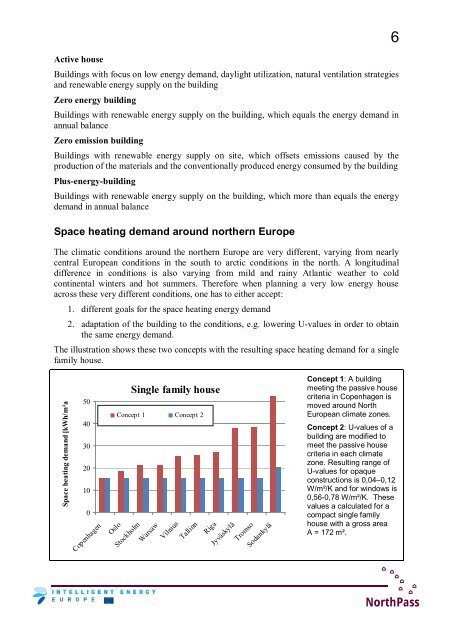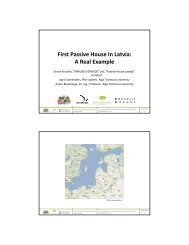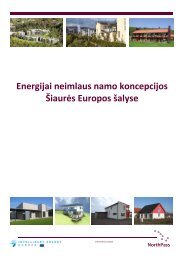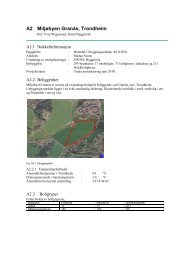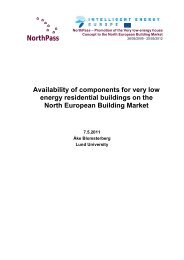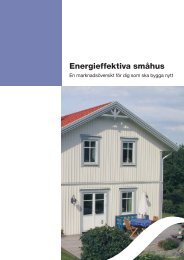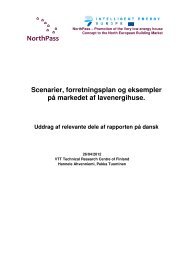Very Low-Energy House Concepts in North European ... - NorthPass
Very Low-Energy House Concepts in North European ... - NorthPass
Very Low-Energy House Concepts in North European ... - NorthPass
Create successful ePaper yourself
Turn your PDF publications into a flip-book with our unique Google optimized e-Paper software.
Active house<br />
Build<strong>in</strong>gs with focus on low energy demand, daylight utilization, natural ventilation strategies<br />
and renewable energy supply on the build<strong>in</strong>g<br />
Zero energy build<strong>in</strong>g<br />
Build<strong>in</strong>gs with renewable energy supply on the build<strong>in</strong>g, which equals the energy demand <strong>in</strong><br />
annual balance<br />
Zero emission build<strong>in</strong>g<br />
Build<strong>in</strong>gs with renewable energy supply on site, which offsets emissions caused by the<br />
production of the materials and the conventionally produced energy consumed by the build<strong>in</strong>g<br />
Plus-energy-build<strong>in</strong>g<br />
Build<strong>in</strong>gs with renewable energy supply on the build<strong>in</strong>g, which more than equals the energy<br />
demand <strong>in</strong> annual balance<br />
Space heat<strong>in</strong>g demand around northern Europe<br />
The climatic conditions around the northern Europe are very different, vary<strong>in</strong>g from nearly<br />
central <strong>European</strong> conditions <strong>in</strong> the south to arctic conditions <strong>in</strong> the north. A longitud<strong>in</strong>al<br />
difference <strong>in</strong> conditions is also vary<strong>in</strong>g from mild and ra<strong>in</strong>y Atlantic weather to cold<br />
cont<strong>in</strong>ental w<strong>in</strong>ters and hot summers. Therefore when plann<strong>in</strong>g a very low energy house<br />
across these very different conditions, one has to either accept:<br />
1. different goals for the space heat<strong>in</strong>g energy demand<br />
2. adaptation of the build<strong>in</strong>g to the conditions, e.g. lower<strong>in</strong>g U-values <strong>in</strong> order to obta<strong>in</strong><br />
the same energy demand.<br />
The illustration shows these two concepts with the result<strong>in</strong>g space heat<strong>in</strong>g demand for a s<strong>in</strong>gle<br />
family house.<br />
6<br />
Space heat<strong>in</strong>g demand [kWh/m²a]<br />
50<br />
40<br />
30<br />
20<br />
10<br />
0<br />
Copenhagen<br />
S<strong>in</strong>gle family house<br />
Concept 1 Concept 2<br />
Oslo<br />
Stockholm<br />
Warsaw<br />
Vilnius<br />
Tall<strong>in</strong>n<br />
Riga<br />
Jyväskylä<br />
Tromso<br />
Sodankylä<br />
Concept 1: A build<strong>in</strong>g<br />
meet<strong>in</strong>g the passive house<br />
criteria <strong>in</strong> Copenhagen is<br />
moved around <strong>North</strong><br />
<strong>European</strong> climate zones.<br />
Concept 2: U-values of a<br />
build<strong>in</strong>g are modified to<br />
meet the passive house<br />
criteria <strong>in</strong> each climate<br />
zone. Result<strong>in</strong>g range of<br />
U-values for opaque<br />
constructions is 0,04–0,12<br />
W/m²/K and for w<strong>in</strong>dows is<br />
0,56-0,78 W/m²/K. These<br />
values a calculated for a<br />
compact s<strong>in</strong>gle family<br />
house with a gross area<br />
A = 172 m².<br />
<strong>North</strong>Pass


